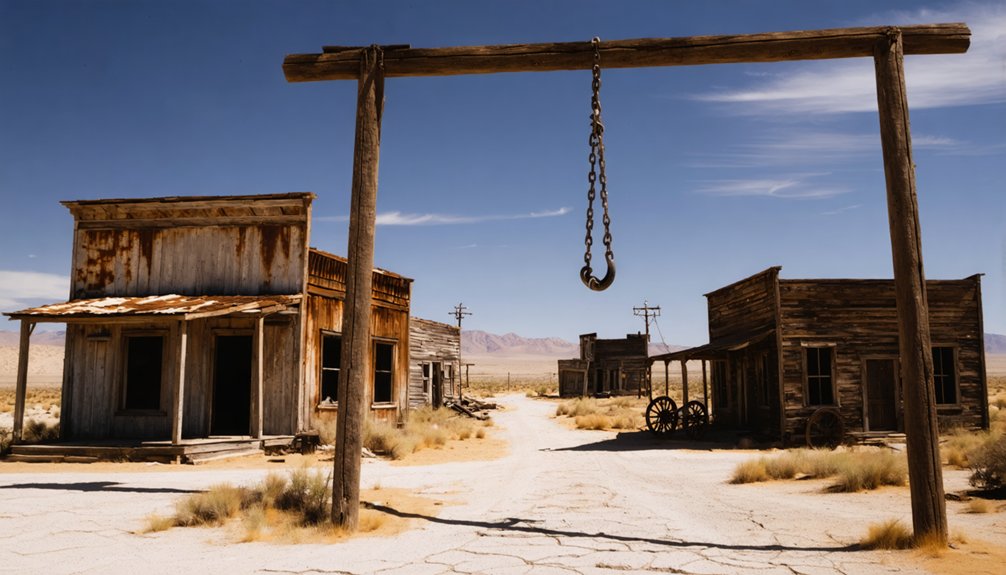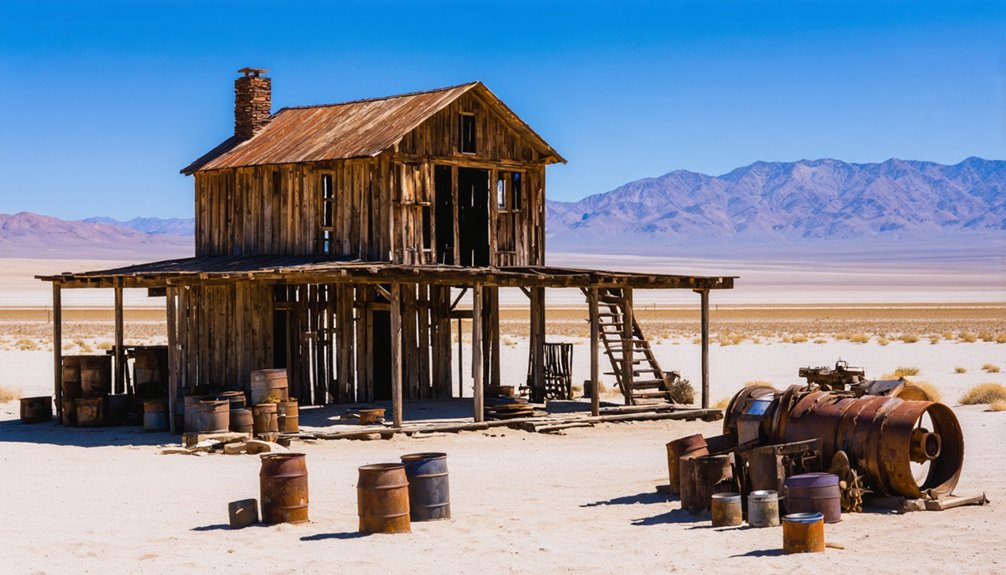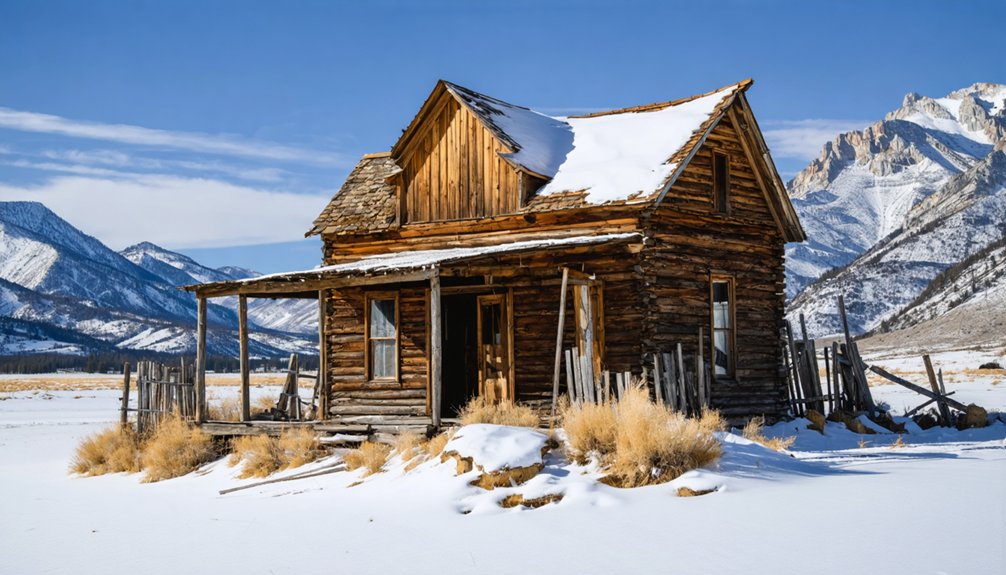Skidoo was a gold mining town in Death Valley that flourished from 1906-1917, producing $1.6 million in gold. You’ll find it named after the slang phrase “23 skidoo,” with a peak population of 700 residents. The town boasted a remarkable 20-mile water pipeline, newspaper, bank, and school before declining when ore reserves depleted. Today, its preserved ruins within Death Valley National Park tell a fascinating story of boom-and-bust frontier economics.
Key Takeaways
- Skidoo was a gold mining town established in 1906 that flourished until 1917, producing approximately 75,000 ounces of gold worth $1.6 million.
- The town featured impressive infrastructure including a 20-mile water pipeline, electricity, a newspaper, bank, school, and telephone service.
- At its peak, Skidoo had a population of 700 people with a relatively peaceful community compared to other mining towns.
- The town declined after 1917 when gold reserves were depleted, leading to a mass exodus and complete abandonment by 1942.
- Today, Skidoo’s ruins are preserved within Death Valley National Park, with the 15-stamp mill being the primary surviving structure.
The Birth of a Desert Gold Camp (1906)
In the frigid January of 1906, the desolate landscape of the Panamint Range witnessed a pivotal discovery that would transform an overlooked patch of desert into a bustling gold camp.
John Ramsey and John “One Eye” Thompson, winded but determined, discovered free gold on the Skidoo ledge near Emigrant Spring—a find previous miners had missed while focusing on silver and lead.
News of the Gold Eagle strike spread like wildfire. You’d have seen a remarkable transformation as prospectors abandoned their Harrisburg-bound journeys to flock to Skidoo instead.
Gold fever redirects destiny—prospectors trade Harrisburg dreams for Skidoo’s golden promise in an instant.
Desert survival skills proved essential as miners and families established over 30 tents and frame buildings by mid-1906.
The first assays revealed an impressive yield of $82 per ton of gold, validating the excitement surrounding the new discovery.
Despite the harsh mountain terrain, gold prospecting enthusiasm fueled rapid development, culminating in a proper townsite platted east of Skidoo Mine by August’s end.
The settlement’s elevation at 5,689 feet posed additional challenges for residents adapting to the extreme temperature variations typical of high desert environments.
From “23 Skidoo” to Official Town: Naming and Early Development
As the scattered tents and makeshift shelters multiplied across the Panamint Range, this nameless collection of prospectors required an identity to match its growing ambitions.
“Skidoo,” a term that captured the era’s vernacular spirit, emerged from the popular slang phrase “23 skidoo“—an expression suggesting one should leave quickly or seize an opportunity while possible. Established in 1906, the settlement quickly grew into a bustling mining community with a peak population of 700 during the height of gold mining activities. The townsite was officially marked in August 1906, cementing Skidoo’s transformation from mining camp to established town.
Peak Prosperity: Life in Skidoo During the Boom Years
Between 1906 and 1917, Skidoo transformed from a fledgling mining outpost into one of California’s most productive gold camps, reaching its zenith around 1907 when the population swelled to 400-700 residents.
Unlike typical transient mining camps, Skidoo developed substantial community dynamics with a newspaper, bank, school, and telephone service—indicating families had settled alongside miners.
The town’s economic prosperity was remarkable, yielding approximately 75,000 ounces of gold worth $1,600,000.
Skidoo’s golden treasury of 75,000 ounces transformed a desert outpost into a million-dollar economic miracle.
The Skidoo Mine Company employed about 35 men at its core operation, with nearly 100 workers throughout the district during peak production.
A sophisticated infrastructure supported this desert boomtown, including a 20-mile water pipeline and electrical service.
The peaceful atmosphere of Skidoo distinguished it from other rowdy mining towns of the era, creating a more civil community.
Monthly production generated around $14,400 with profits of $4,800 during 1911-1912, sustaining both the community and shareholder dividends.
The community was originally known as Hoveck, named after Matt Hoveck who managed the Skidoo Mine before the town adopted its more famous moniker.
Engineering Marvel: The 20-Mile Pipeline That Made Mining Possible
The twenty-mile pipeline that transformed Skidoo from barren desert outpost to productive mining town stands as one of early 20th-century California’s most remarkable engineering achievements.
Owner Bob Montgomery secured water rights from springs near Telescope Peak, enabling gravity-fed water to flow across harsh terrain to power Skidoo’s quartz mill operations.
This ambitious project required:
- 75 dedicated workers laying pipe sections across 20-23 miles of desert
- Strategic use of 7,400-foot elevation to create natural pressure
- Watering stations established along the route for prospectors
- Over $300,000 in total mining development investment
Despite impressive engineering, pipeline challenges eventually contributed to Skidoo’s demise.
Freezing temperatures in winter 1913 caused pipes to burst, forcing layoffs and triggering the town’s decline as repairs proved difficult in the remote location.
Social Structure and Daily Life in an Isolated Mining Town
Nestled atop the remote Panamint Range, Skidoo evolved from a makeshift mining camp into a structured community with distinct social hierarchies and daily routines that mirrored larger American settlements despite its isolation.
You’d find clear social stratification in the town’s layout and institutions. The exclusive Panamint Club charged initiation fees, while professionals like physicians and lawyers occupied different social tiers from the miners and service workers. The town thrived for a decade from 1907, extracting 75,000 ounces of gold from the surrounding mountains.
Women managed boarding houses and performed domestic duties in this male-dominated environment.
The feminine presence in Skidoo remained confined to domestic spheres, operating boardinghouses while navigating a landscape dominated by male interests.
For recreation, you could join one of two baseball teams or attend gatherings at dance halls and saloons—the heart of evening entertainment. The community experienced periods of lawlessness and revelry similar to what characterized social life in Bodie and other mining towns.
Living quarters ranged from simple tents to proper wooden structures, with managers enjoying better accommodations.
Despite harsh conditions, residents established schools, newspapers, and commercial services, creating a remarkably complete society in this desolate setting.
Gold Production and Mining Operations
Gold production from Skidoo’s mines yielded approximately $1.5 million during its operational lifespan, making it one of the more profitable ventures in the Panamint Range.
You’ll find the gold mining operations were quite sophisticated for their time, utilizing narrow vein mining techniques to extract ore valued between $14-$28 per ton. The Skidoo Mines Company completed construction of a stamp mill and cyanide plant in early 1908.
The ore processing system at Skidoo followed four essential steps:
- Crushing the ore using a stamp mill initially equipped with 10 stamps
- Amalgamation with mercury to capture free gold
- Concentration of gold-bearing material
- Cyanide treatment to extract remaining gold
Law and Order in the Desert: Frontier Justice in Skidoo

While the riches of Skidoo’s mines attracted prospectors seeking fortune, they also drew individuals of questionable character to this remote desert settlement.
With limited formal law enforcement, the community established its own brand of frontier justice through communal decision making.
You’d find that miners’ tribunals and vigilance committees formed the backbone of Skidoo’s legal system, blending Anglo-American traditions with practical necessity.
The infamous 1902 lynching of Joe Simpson—dragged from jail and hanged from a telegraph pole—exemplified this harsh approach to maintaining order.
Justice at the end of a rope — Skidoo’s answer to lawlessness in the California desert.
Justice was swift and public, often delivered within hours.
These mining camp tribunals often lacked formal procedures, with minimal cross-examination and verdicts influenced more by reputation and rumor than established evidence.
The Skidoo Board of Trade attempted to organize formal peacekeeping around 1907, but vigilante justice remained the primary method of control in this lawless terrain where expediency trumped procedural fairness.
The Slow Fade: Decline and Abandonment After 1917
After the heyday of Skidoo’s mining prosperity, signs of decline became increasingly apparent by 1917, marking the beginning of the town’s gradual dissolution.
Despite attempts at community resilience, Skidoo’s fate was sealed when ore reserves became fully depleted in September 1917, ending the mining legacy that had produced 75,000 ounces of gold valued at $1.5 million.
The town’s demise followed a predictable pattern:
- Essential services disappeared as the post office and school closed
- Mass exodus occurred once the economic foundation collapsed
- Brief revival attempts in the 1930s proved ultimately futile
- Operations ceased completely by 1942, surrendering the town to desert reclamation
You’ll find little remaining of Skidoo today—just mill equipment standing as silent sentinels to a boom-and-bust cycle that defined many Western mining settlements.
Preserved in Time: Skidoo’s Ruins and Historical Significance Today

Remnants of Skidoo’s past stand as silent witnesses to the town’s golden era, preserved within the boundaries of Death Valley National Park.
Today, the 15-stamp mill remains the primary surviving structure, closed to climbing for heritage preservation purposes.
As you explore the site, you’ll find scattered debris marking where this once-thriving community processed over 75,000 ounces of gold. Unlike many abandoned mining operations, Skidoo’s mill enjoys relatively good conservation compared to others throughout the valley.
The ghost town exemplifies California gold rush settlement patterns, positioned strategically east of its mine operations.
Skidoo’s layout reveals the practical wisdom of early miners—placing settlements downslope from excavation sites for efficient resource flow.
While tourist impact is carefully managed, you can still access the ruins to connect with this slice of American mining history—a reflection of the boom-and-bust cycle that shaped the West’s economic landscape.
Frequently Asked Questions
Can Visitors Legally Collect Artifacts or Souvenirs From Skidoo Today?
No, you can’t legally collect artifacts from Skidoo. Federal regulations strictly prohibit artifact collection within Death Valley National Park to preserve these irreplaceable cultural resources for everyone’s future enjoyment and study.
Were There Any Notable Women Who Played Important Roles in Skidoo?
In the shadows of history, you’ll find pioneering women made vital community contributions through teaching, running boarding houses, and managing essential businesses like laundries and restaurants that sustained Skidoo’s brief existence.
What Happened to the Gold Mining Equipment After Abandonment?
You’ll find most gold mining equipment was left behind at Skidoo. Larger machinery remained in place without systematic equipment disposal, while miners likely took smaller, portable tools when departing.
Did Any Famous Historical Figures Ever Visit Skidoo?
Like a beacon drawing moths, Skidoo attracted Charles M. Schwab, the steel titan, who visited to inspect his investments. Senator Nixon also made the journey, enhancing the mining town’s historical significance.
How Did Residents Handle Medical Emergencies in Such a Remote Location?
You’d rely on basic medical supplies, Dr. McDonald’s care, and home remedies. Without emergency communication systems, serious cases meant slow, difficult travel to Los Angeles for advanced treatment.
References
- https://www.legendsofamerica.com/ca-skidoo/
- https://westernmininghistory.com/towns/california/skidoo/
- https://en.wikipedia.org/wiki/Skidoo
- https://www.youtube.com/watch?v=RrsE02Qpgx4
- https://digital-desert.com/death-valley-history/skidoo.html
- http://www.backcountryexplorers.com/skidoo-death-valley.html
- https://beyond.nvexpeditions.com/california/inyo/skidoo.php
- https://www.ghosttowns.com/states/ca/skidoo.html
- https://www.youtube.com/watch?v=O_Hk4njyNbU
- https://www.nps.gov/parkhistory/online_books/deva/section3b2t.htm



